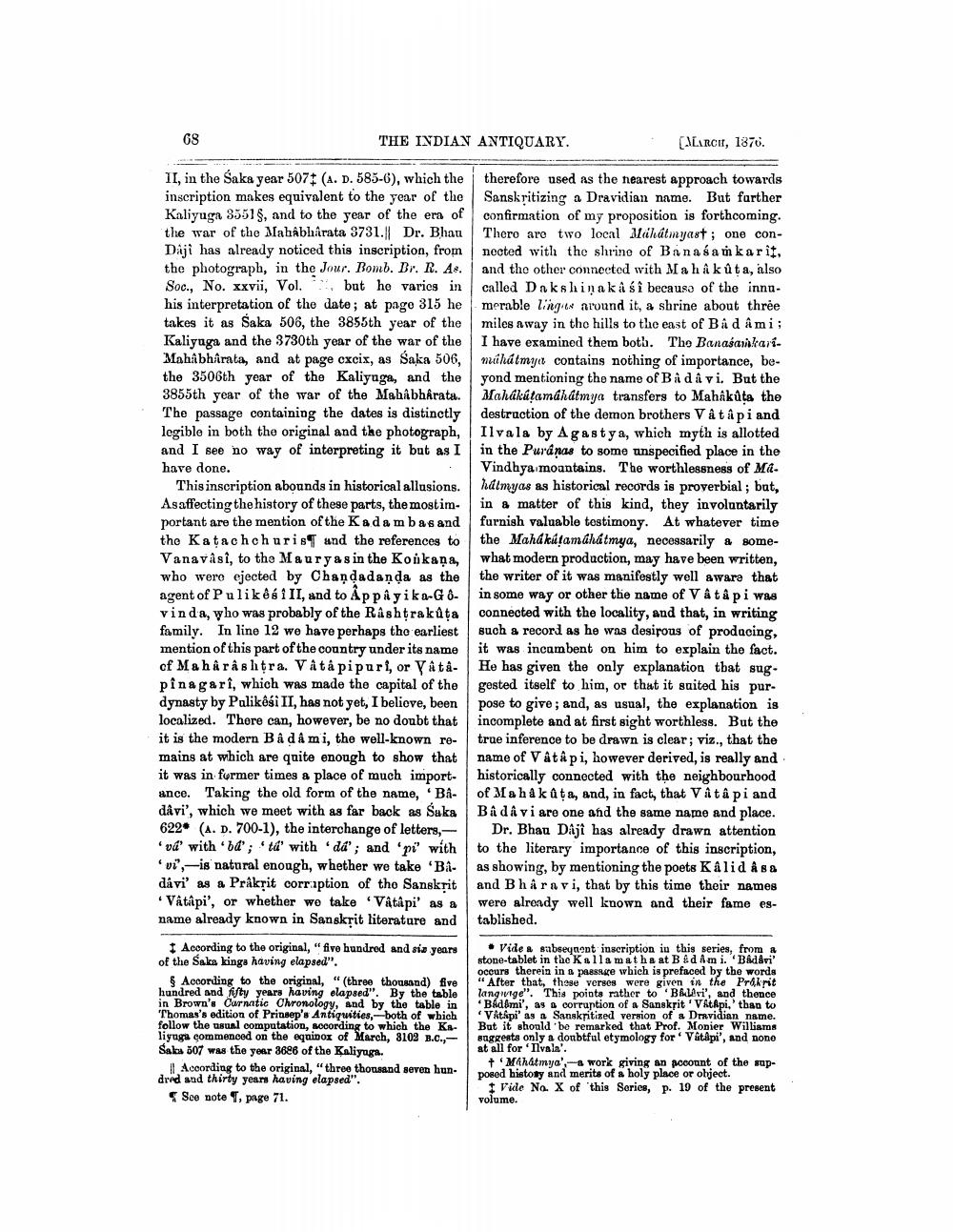________________
68
THE INDIAN ANTIQUARY.
II, in the Saka year 507 (A. D. 585-6), which the inscription makes equivalent to the year of the Kaliyuga 3551§, and to the year of the era of the war of the Mahabharata 3731.|| Dr. Bhau Daji has already noticed this inscription, from the photograph, in the Jour. Bomb. Br. R. As. Soc., No. xxvii, Vol., but he varies in his interpretation of the date; at page 315 he takes it as Saka 506, the 3855th year of the Kaliyuga and the 3730th year of the war of the Mahabharata, and at page cxcix, as Saka 506, the 3506th year of the Kaliyuga, and the 3855th year of the war of the Mahabharata. The passage containing the dates is distinctly legible in both the original and the photograph, and I see no way of interpreting it but as I have done.
This inscription abounds in historical allusions. As affecting the history of these parts, the most important are the mention of the Kadam bas and the Kaṭachchuris and the references to Vanavasi, to the Mauryas in the Konkana, who were ejected by Chandadanda as the agent of Pulikê é i II, and to Appâyika-G ôvinda, who was probably of the Rashtrakuta family. In line 12 we have perhaps the earliest mention of this part of the country under its name of Maharashtra. Vâtâpipuri, or Yâtâpinagari, which was made the capital of the dynasty by Palikêsi II, has not yet, I believe, been localized. There can, however, be no doubt that it is the modern Bâdâ mi, the well-known remains at which are quite enough to show that it was in former times a place of much importance. Taking the old form of the name, 'Bâdâvi', which we meet with as far back as Saka 622 (A. D. 700-1), the interchange of letters,'va' with 'ba'; ta' with 'da'; and 'pi' with 'vi', is natural enough, whether we take 'Bâdávi' as a Prakrit corruption of the Sanskrit
Vâtâpi', or whether we take Vâtâpi' as a name already known in Sanskrit literature and
According to the original, "five hundred and six years of the Saka kings having elapsed".
According to the original, "(three thousand) five hundred and fifty years having elapsed". By the table in Brown's Carnatic Chronology, and by the table in Thomas's edition of Prinsep's Antiquities,-both of which follow the usual computation, according to which the Kaliyuga commenced on the equinox of March, 8102 B.C.,Saka 507 was the year 3626 of the Kaliyuga.
According to the original, "three thousand seven hundred and thirty years having elapsed".
Sce note T, page 71.
[MARCH, 1876.
therefore used as the nearest approach towards Sanskritizing a Dravidian name. But further confirmation of my proposition is forthcoming. There are two local Mahatmyast; one connected with the shrine of Banasamkarit, and the other connected with Ma hâk û ta, also called Dakshinakasi because of the innumerable lings around it, a shrine about three miles away in the hills to the east of Bâdâmi; I have examined them both. The Banasamkarimahatmya contains nothing of importance, beyond mentioning the name of Badavi. But the Mahakaṭamáhatmya transfers to Mahakuta the destruction of the demon brothers V â tâpi and Ilvala by Agastya, which myth is allotted in the Puranas to some unspecified place in the Vindhya mountains. The worthlessness of Máhatmyas as historical records is proverbial; but, in a matter of this kind, they involuntarily furnish valuable testimony. At whatever time the Mahákáṭamáhatmya, necessarily a somewhat modern production, may have been written, the writer of it was manifestly well aware that in some way or other the name of V â tâpi was connected with the locality, and that, in writing such a record as he was desirous of producing, it was incumbent on him to explain the fact. He has given the only explanation that suggested itself to him, or that it suited his purpose to give; and, as usual, the explanation is incomplete and at first sight worthless. But the true inference to be drawn is clear; viz., that the name of Vâtapi, however derived, is really and historically connected with the neighbourhood of Mahakûṭa, and, in fact, that Vitâ pi and Bâdâvi are one and the same name and place.
Dr. Bhau Dâjî has already drawn attention to the literary importance of this inscription, as showing, by mentioning the poets Kâlid å sa and Bharavi, that by this time their names were already well known and their fame established.
Vide a subsequent inscription in this series, from a stone-tablet in the Kallamatha at B&dami. 'Bâdâvi' occurs therein in a passage which is prefaced by the words "After that, these verses were given in the Prakrit langwige". This points rather to Bavi', and thence Badêmi', as a corruption of a Sanskrit VitApi,' than to VitApi' as a Sanskritized version of a Dravidian name. But it should be remarked that Prof. Monier Williams suggests only a doubtful etymology for Vitâpi', and none at all for 'Ilvala".
"
Mahatmya', a work giving an account of the supposed history and merits of a holy place or object.
Vide No. X of this Series, p. 19 of the present volume.




